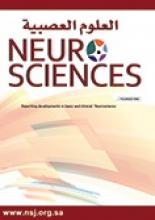Research ArticleOriginal Article
Open Access
Tolerability of propofol in Wada testing
Faisal A. Alsallom, Shobhit Sinha, Fahmi M. Alsenani, Fawziah A. Bamogaddam, Saeed H. Wahass, Aurora B. Canillo and Khurram A. Siddiqui
Neurosciences Journal July 2014, 19 (3) 218-223;
Faisal A. Alsallom
From the Departments of Neurology (Alsallom, Alsenani, Bamogaddam, Canillo), Neuroradiology (Alsenani), and Neuropsychology (Wahass), National Neurosciences Institute, King Fahad Medical City, Riyadh, Kingdom of Saudi Arabia, the Department of Medicine (Sinha) Division of Neurology, Al-Mafraq Hospital, Abu Dhabi, and the Department of Neurology (Siddiqui), Medical Institute, Al-Ain Hospital, Al-Ain, United Arab Emirates
MBBSShobhit Sinha
From the Departments of Neurology (Alsallom, Alsenani, Bamogaddam, Canillo), Neuroradiology (Alsenani), and Neuropsychology (Wahass), National Neurosciences Institute, King Fahad Medical City, Riyadh, Kingdom of Saudi Arabia, the Department of Medicine (Sinha) Division of Neurology, Al-Mafraq Hospital, Abu Dhabi, and the Department of Neurology (Siddiqui), Medical Institute, Al-Ain Hospital, Al-Ain, United Arab Emirates
MBBS,FRCPFahmi M. Alsenani
From the Departments of Neurology (Alsallom, Alsenani, Bamogaddam, Canillo), Neuroradiology (Alsenani), and Neuropsychology (Wahass), National Neurosciences Institute, King Fahad Medical City, Riyadh, Kingdom of Saudi Arabia, the Department of Medicine (Sinha) Division of Neurology, Al-Mafraq Hospital, Abu Dhabi, and the Department of Neurology (Siddiqui), Medical Institute, Al-Ain Hospital, Al-Ain, United Arab Emirates
MBBS,MScFawziah A. Bamogaddam
From the Departments of Neurology (Alsallom, Alsenani, Bamogaddam, Canillo), Neuroradiology (Alsenani), and Neuropsychology (Wahass), National Neurosciences Institute, King Fahad Medical City, Riyadh, Kingdom of Saudi Arabia, the Department of Medicine (Sinha) Division of Neurology, Al-Mafraq Hospital, Abu Dhabi, and the Department of Neurology (Siddiqui), Medical Institute, Al-Ain Hospital, Al-Ain, United Arab Emirates
MDSaeed H. Wahass
From the Departments of Neurology (Alsallom, Alsenani, Bamogaddam, Canillo), Neuroradiology (Alsenani), and Neuropsychology (Wahass), National Neurosciences Institute, King Fahad Medical City, Riyadh, Kingdom of Saudi Arabia, the Department of Medicine (Sinha) Division of Neurology, Al-Mafraq Hospital, Abu Dhabi, and the Department of Neurology (Siddiqui), Medical Institute, Al-Ain Hospital, Al-Ain, United Arab Emirates
PhDAurora B. Canillo
From the Departments of Neurology (Alsallom, Alsenani, Bamogaddam, Canillo), Neuroradiology (Alsenani), and Neuropsychology (Wahass), National Neurosciences Institute, King Fahad Medical City, Riyadh, Kingdom of Saudi Arabia, the Department of Medicine (Sinha) Division of Neurology, Al-Mafraq Hospital, Abu Dhabi, and the Department of Neurology (Siddiqui), Medical Institute, Al-Ain Hospital, Al-Ain, United Arab Emirates
BSKhurram A. Siddiqui
From the Departments of Neurology (Alsallom, Alsenani, Bamogaddam, Canillo), Neuroradiology (Alsenani), and Neuropsychology (Wahass), National Neurosciences Institute, King Fahad Medical City, Riyadh, Kingdom of Saudi Arabia, the Department of Medicine (Sinha) Division of Neurology, Al-Mafraq Hospital, Abu Dhabi, and the Department of Neurology (Siddiqui), Medical Institute, Al-Ain Hospital, Al-Ain, United Arab Emirates
MBBS,FRCP
References
- ↵
- Wada J,
- Rasmussen T
- ↵
- Baxendale S
- ↵
- Mariappan R,
- Manninen P,
- McAndrews MP,
- Cohn M,
- Tai P,
- Valiante T,
- et al.
- ↵
- Patel A,
- Wordell C,
- Szarlej D
- ↵
- Larner AJ,
- Mitchell AJ
- ↵
- Coren S
- ↵
- Roid GH,
- Barram RA
- ↵
- Bjelland I,
- Dahl AA,
- Haug TT,
- Neckelmann D
- ↵
- Carlson RV,
- Boyd KM,
- Webb DJ
- ↵
- Fujii M,
- Miyachi S,
- Matsubara N,
- Kinkori T,
- Takebayashi S,
- Izumi T,
- et al.
- ↵
- Mikati MA,
- Naasan G,
- Tarabay H,
- El Yamen S,
- Baydoun A,
- Comair YG
- ↵
- Mikuni N,
- Takayama M,
- Satow T,
- Yamada S,
- Hayashi N,
- Nishida N,
- et al.
- ↵
- Takayama M,
- Miyamoto S,
- Ikeda A,
- Mikuni N,
- Takahashi JB,
- Usui K,
- et al.
- ↵
- Yamaguchi T,
- Shojima M,
- Delashaw JB Jr.,
- Watanabe E
- ↵
- Loddenkemper T,
- Möddel G,
- Dinner DS,
- Kim H,
- Schuele SU,
- Alexopoulos AV,
- et al.
- ↵
- Kim JH,
- Joo EY,
- Han SJ,
- Cho JW,
- Lee JH,
- Seo DW,
- et al.
- ↵
- Kowacs PA,
- Mattei TA,
- Goulart CR,
- da Rocha SF,
- Ramina R,
- Simão CA,
- et al.
- ↵
- Rang HP,
- Dale MM,
- Ritter JM,
- Flower RJ,
- Henderson G
- ↵
- Miller RD
- Reves JG,
- Glass P,
- Lubarsky DA,
- McEvoy MD,
- Martinez-Ruiz R
- ↵
- Bazin JE,
- Picard P,
- Gabrillargues J,
- Dordain M
- ↵
- Silva TM,
- Hernández-Fustes OJ,
- Bueno ML,
- Varela AM,
- Machado S
- ↵
- Magee JA,
- Pender NP,
- Abrahams S,
- Thornton J,
- Delanty N,
- Fortune GM
- ↵
- Jo YY,
- Kwak HJ,
- Lee MG,
- Lim OK
- ↵
- Röhm KD,
- Riechmann J,
- Boldt J,
- Suttner SW,
- Piper SN
- ↵
- Coon AL,
- Colby GP,
- Mack WJ,
- Feng L,
- Meyers P,
- Sander Connolly E Jr.
- ↵
- Vijayvergiya R,
- Otaal PS,
- Bagga S,
- Modi M
- ↵
- Bonnet U
- ↵
- Koopmann A,
- von der Goltz C,
- Hermann D,
- Kiefer F
- ↵
- Möddel G,
- Lineweaver T,
- Schuele SU,
- Reinholz J,
- Loddenkemper T
- ↵
- Van den Heuvel I,
- Wurmb TE,
- Böttiger BW,
- Bernhard M
- ↵
- Hartle AJ,
- Peel PH
In this issue
Tolerability of propofol in Wada testing
Faisal A. Alsallom, Shobhit Sinha, Fahmi M. Alsenani, Fawziah A. Bamogaddam, Saeed H. Wahass, Aurora B. Canillo, Khurram A. Siddiqui
Neurosciences Journal Jul 2014, 19 (3) 218-223;
Jump to section
Related Articles
Cited By...
- No citing articles found.





